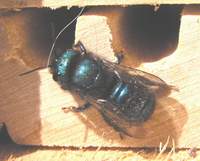

Attracting Solitary Bees Bees are some of our best pollinators, and 30% of our food supply is dependent on bees for pollination, as well as the fruits and flowers in our home gardens. Right now the Honey bee is in decline due to mite infestation, however, this bee is not our only pollinator - other bees, known as "Solitary" bees are just as hard working but because of their small size they go unnoticed and due to lack of knowledge about these fascinating insects, are greatly under appreciated. In most cases, mention the word "Bee" and most people will be squirming, recalling tales of bee stings and thus labeling all bees as bad. Unfortunately the bees that do sting, such as the wasps, hornets, yellow jackets and occasionally the honeybees, give these other Solitary bees a bad name and instantly cause fear. In most cases bees will ONLY sting if roughly handled.
Orchard Mason Bees...
The Mason Bee - Osmia lignaria (photo above) is a small blue / black bee, approximately 10-13mm long, the males being a little slimmer in size and are an iridescent black/blue in color. They do not drill their own holes but nest in pre-made holes in wood, either man made or those made by wood borers and woodpeckers, hence their name. There is a lack of suitable nesting places for solitary bees. This is due to habitat destruction and man's obsession for keeping things neat and tidy by removing old tree stumps, clearing up brush and log piles and generally dead wood. However we can help by providing nest boxes.  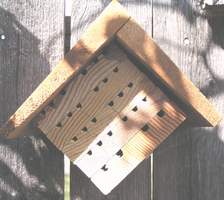 The house on the left is a "High Rise" Mason bee house from Beediverse.com with layers of wood routered with 5/16th holes. This will attract both Mason and Leafcutter Bees. The house on the right has smaller nest holes and is for the smaller Solitary bee such as Aphid bees. Boxes can be homemade with 6" deep blocks of wood but to help promote healthy populations of Mason bees the use of routered trays is definately the best type of nest box to use. These come apart in layers (photos above) so the cells can be checked for parasites and cleaned out at the end of the season.
The Nesting Cycle... Female Mason Bees begin nesting in early spring, around mid March here in North Central Texas. They will mate and then will begin searching for nest holes to lay eggs in. Once they find a suitable nest site they will gather mud and begin making a cell in the deepest part of the hole. This is done at the perfect time when fruit tree blossoms are at their peak. They then will place a block pollen in the cell. On top of this they will lay 1 white egg and then seal the cell with more mud. They will repeat this until the length of the hole is filled with approximately 6 cells, or chambers, each time laying one egg and a block of pollen. After her eggs have been laid she will die. The adult part of a bees life only lasts for about 6 weeks.  Mud sealing a Mason Bee hole The small white eggs will stay at this stage for about 1-3 weeks and then hatch. After this they grow quickly, feeding on the block of pollen given them. The larva will then change into a pupa and will remain this way in hibernation for anywhere up to 9 months over the winter. The following spring they will hatch out beginning with the last born, which is at the entrance of the hole. He (most eggs at the front being males) will chew his way through the mud door and the one behind him will then come forward. If the one at the back is awake before the one in front she will chew her way out and then nip the back end of the bee in front, encouraging that one to move forward! Once all the bees have emerged the cycle begins again. Leafcutter Bees... The first year in using my homemade box, as well as having two nest holes being used by Mason Bees I also attracted a couple of Leafcutter bees. Like Mason Bees and just as fascinating, Leafcutters have a similar nesting style and will nest in the same wooden bee boxes except, as their name suggests, they line their cells with small pieces of leaves instead of mud. It is these bees that will leave those little chewed edges on your Roses! They also will take leaves from other plants that produce smooth, thin leaves such as Ash trees, Redbuds & Bourganvilleas, even the petals from plants such as Crepe Myrtle's. They will nest through the summer peaking around June/July. 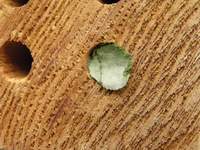 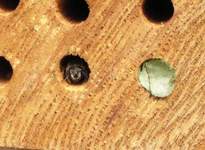  Left to right: Here one of the holes has been filled with cells and sealed with the final cap of leaves. A Leafcutter bee defending a hole. Leafcutter leaving the nest to gather more leaves.  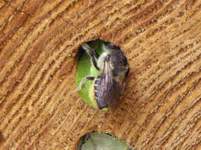 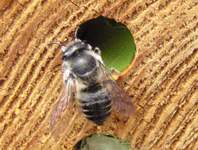 Bringing in another leaf & postitioning the leaf toward the front of a second hole for a good seal.  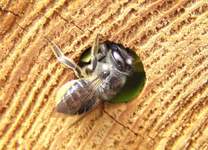  Here you can see how the bee curves the leaf under her abdomen for flying. The yellow under her abdomen is pollen caught by the stiff bristle like hairs. Finally she positions the leaf and the entry hole is almost complete. A final cap will finish it like seen in the first photo.  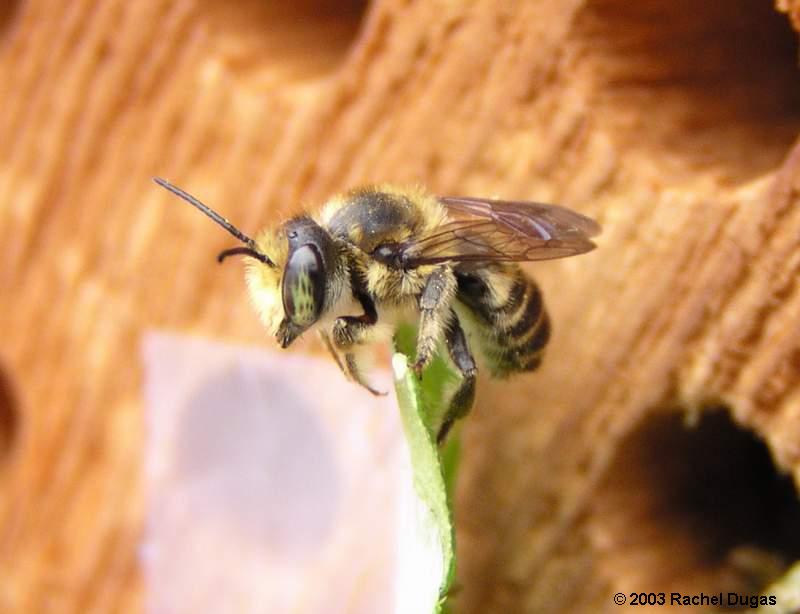 Left: Here a new adult bee has eaten its way out to the entrance and is getting ready to leave. Notice how yellow its head is compared to the adult above. Right: I stuck a piece of leaf to the box just so I could watch the bee walk onto it and had time to take a quick photo before it flew off! Click on this photo to enlarge. The dates for the bees above were: First nest hole completed April 14th '03. First new bee seen leaving the nest May 17th '03. Unlike Mason Bees which are blue-black in color, Leafcutters are similar in size & color to honeybees, with stripes going across their abdomen in shades of black, grey and tan. They do not collect pollen on their legs like honeybees but instead the females have stiff bristle type hairs on their abdomens designed to trap the pollen from the flowers they visit, coloring them yellow. The males do not have these hairs and his font feet are white. The Native Leafcutter Bees are excellent pollinators of Alfalfa and one particular small species of Leafcutter bee was introduced accidentally into North America from Europe which does this job very well. These bees are used to pollinate crops of alfalfa, each single bee doing the job that would take many honeybees to do. They also have the advantage that they do not seem to get the mite problems that the honeybee does and they do not have the painful sting like that of a wasp, hornet or honeybee, which is good when humans are working in confined areas such as greenhouses alongside pollinating bees. For more info on these fascinating Leafcutter Bees and other solitary bees check out some of the links below. Also, you can click here to see an assortment of Bee & Wasp Photos that I've taken.
Books...
Polination with Mason Bees
Return to - Gardening For Wildlife Gardening for Birds - Gardening for Hummingbirds - Gardening for Butterflies A Garden Pond |

